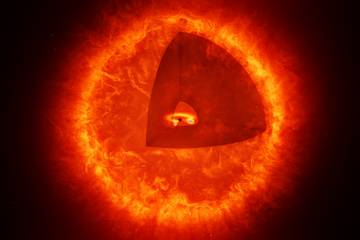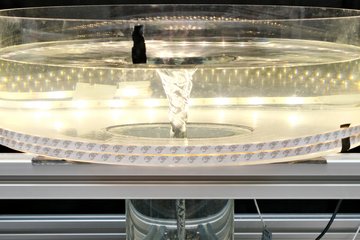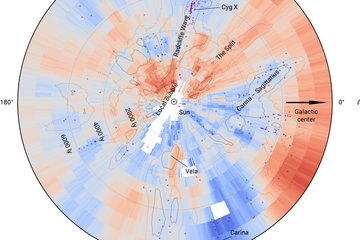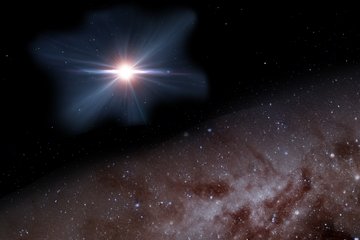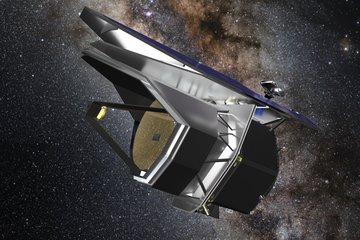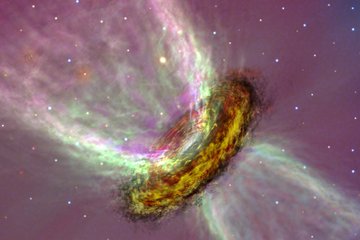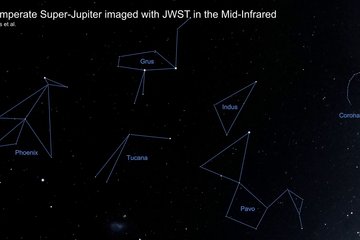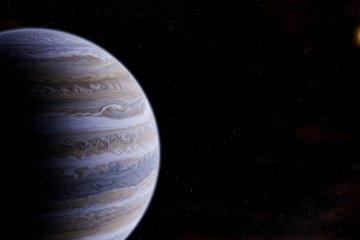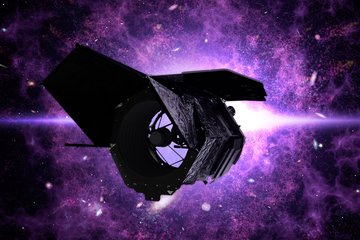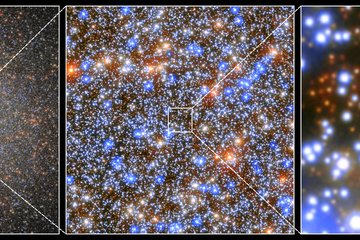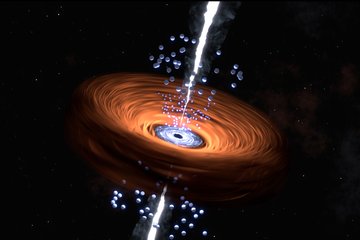Towards a new understanding of the cosmos - First observations within the Sloan Digital Sky Survey V
The just-launched SDSS-V will continue the path-breaking tradition set by the survey's previous generations, with a focus on the ever-changing night sky and the physical processes occurring in the objects that comprise our view of it. SDSS-V is designed to track these transitions, from the flickers and flares of supermassive black holes to the back-and-forth shifts of stars being orbited by distant planets.

This image shows a sampling of data from the first SDSS-V data. The central sky image is a single field of SDSS-V observations. The purple circle indicates the telescope’s field-of-view on the sky, with the full Moon shown as a size comparison. SDSS-V simultaneously observes 500 targets at a time within a circle of this size.
The left panel shows the optical-light spectrum of a quasar--a supermassive black hole at the center of a distant galaxy, which is surrounded by a disk of hot, glowing gas. The purple blob is an SDSS image of the light from this disk, which in this dataset spans about 1 arcsecond on the sky, or the width of a human hair as seen from about 21 meters (63 feet) away. The right panel shows the image and spectrum of a white dwarf -- the left-behind core of a low-mass star (like the Sun) after the end of its life.
“In a year when humanity has been challenged across the globe, I am so proud of the worldwide SDSS team for demonstrating—every day—the very best of human creativity, ingenuity, improvisation, and resilience. It has been a challenging period for the team, but I’m happy to say that the pandemic may have slowed us, but it has not stopped us” said SDSS-V Director, Juna Kollmeier.
Funded primarily by member institutions, along with grants from the Alfred P Sloan Foundation, the U.S. National Science Foundation, and the Heising-Simons Foundation, SDSS-V will focus on three primary areas of investigation, each exploring different aspects of the cosmos using different spectroscopic tools. Together these three project pillars—called “Mappers”—will observe more than six million objects in the sky, and monitor changes in more than a million of those objects over time.
The survey’s Local Volume Mapper will enhance our understanding of galaxy formation and evolution by probing the interactions between the stars that make up galaxies and the interstellar gas and dust that is dispersed between them. The Milky Way Mapper will reveal the physics of stars in our Milky Way, the diverse architectures of its star and planetary systems, and the chemical enrichment of our galaxy since the early universe. The Black Hole Mapper will measure masses and growth over cosmic time of the supermassive black holes that reside in the hearts of galaxies as well as the smaller black holes left behind when stars die.
“We are thrilled to start taking the first data for two of our three Mappers,” added SDSS-V Spokesperson Gail Zasowski, of the University of Utah. “These early observations are already important for a wide range of science goals. Even these first targets cover goals from mapping the inner regions of supermassive black holes and searching for exotic multiple-black hole systems, to studying nearby stars and their dead cores, to tracing the chemistry of potential planet-hosting stars across the Milky Way.”
"In addition to the scientific potential, perhaps the most innovative thing about SDSS-V is that, for the first time, we will enable global spectral scanning of the entire sky” said MPIA director Hans-Walter Rix, who is the Project Scientist of the SDSS-V Organization. Spectroscopy is used to break down the light from celestial objects into its components. This allows a variety of physical properties of the objects to be examined in detail.
SDSS-V will operate out of both Apache Point Observatory in New Mexico, home of the survey’s original 2.5-meter telescope, and Carnegie’s Las Campanas Observatory in Chile, where it uses the 2.5-meter du Pont telescope.
SDSS-V's first observations were gathered in New Mexico with existing SDSS instruments, as a necessary change of plans due to the pandemic. As laboratories and workshops around the world navigate safe reopening, SDSS-V's own suite of new innovative hardware is on the horizon - in particular, systems of automated robots to aim the fiber optic cables used to collect the light from the night sky. These will be installed at both observatories over the next year. New spectrographs and telescopes are also being constructed to enable the Local Volume Mapper observations.
Link to the original press release by the Carnegie Institution for Science at www.sdss5.org
See also here for details on the collaboration and key people and here for an earlier MPIA news release about SDSS-V with further information.
KJ (based on the original press release)

